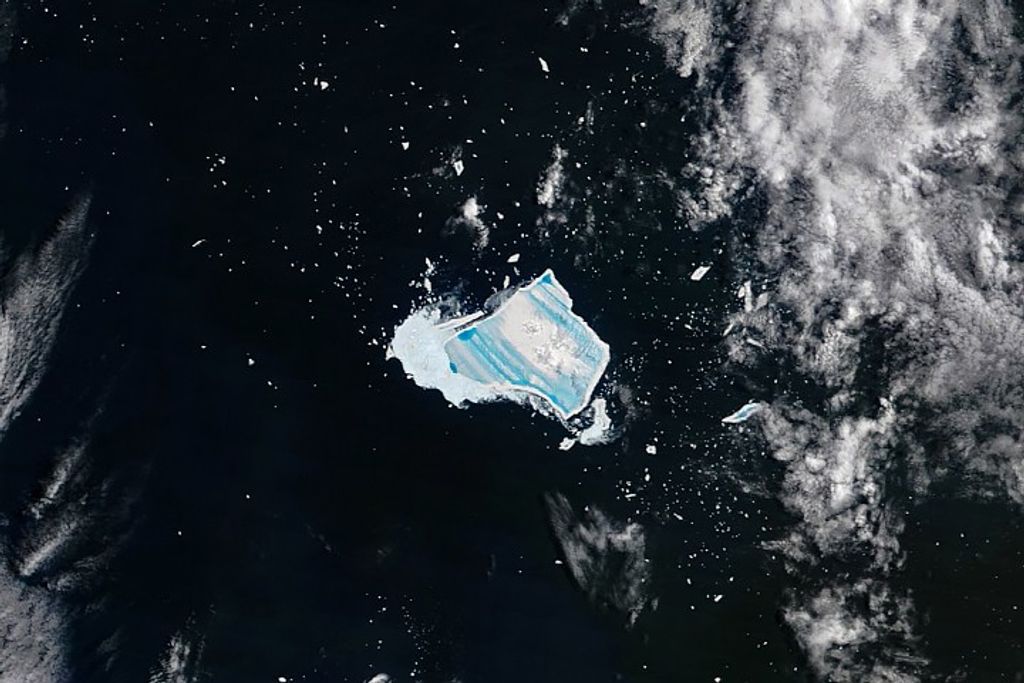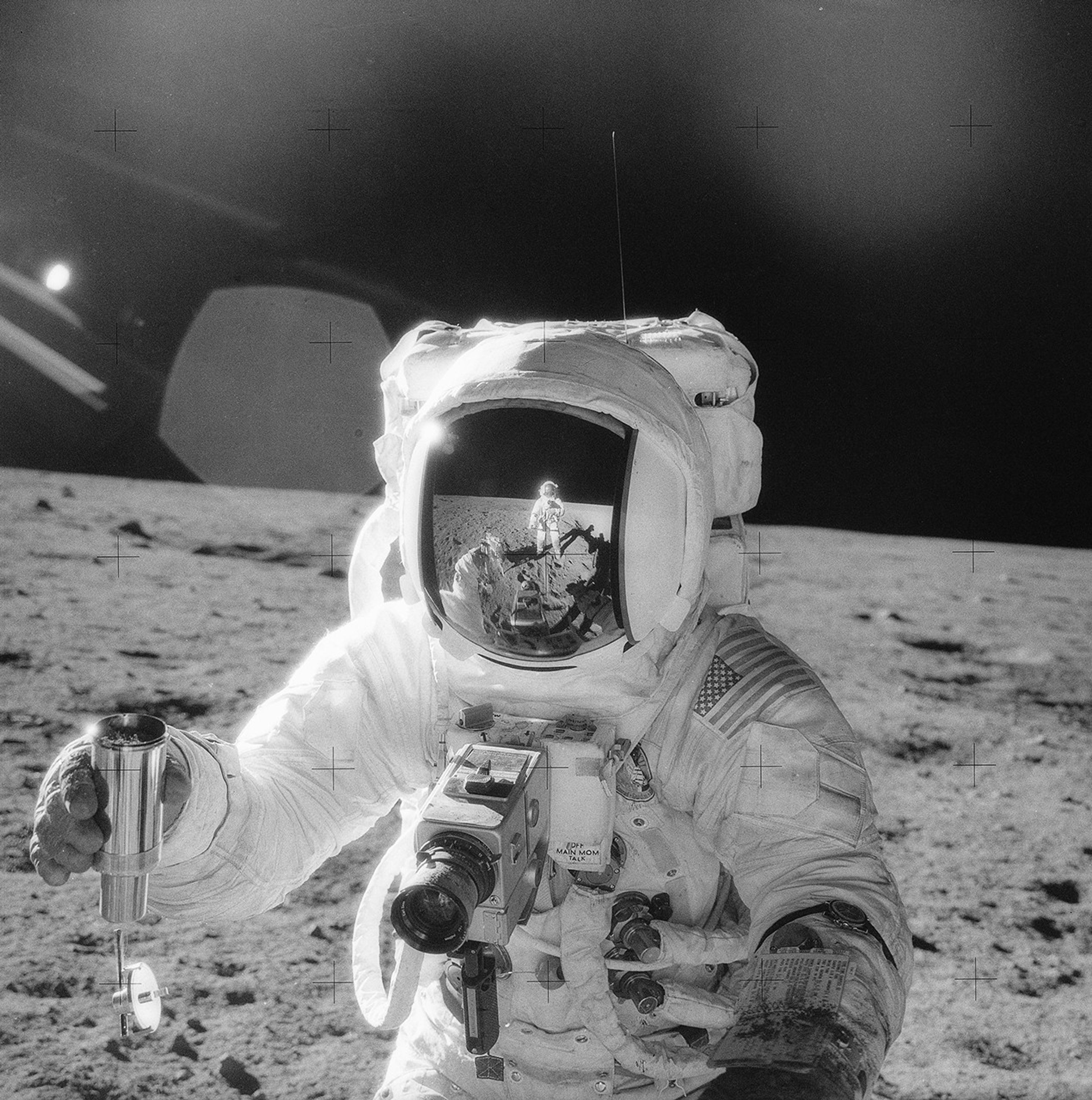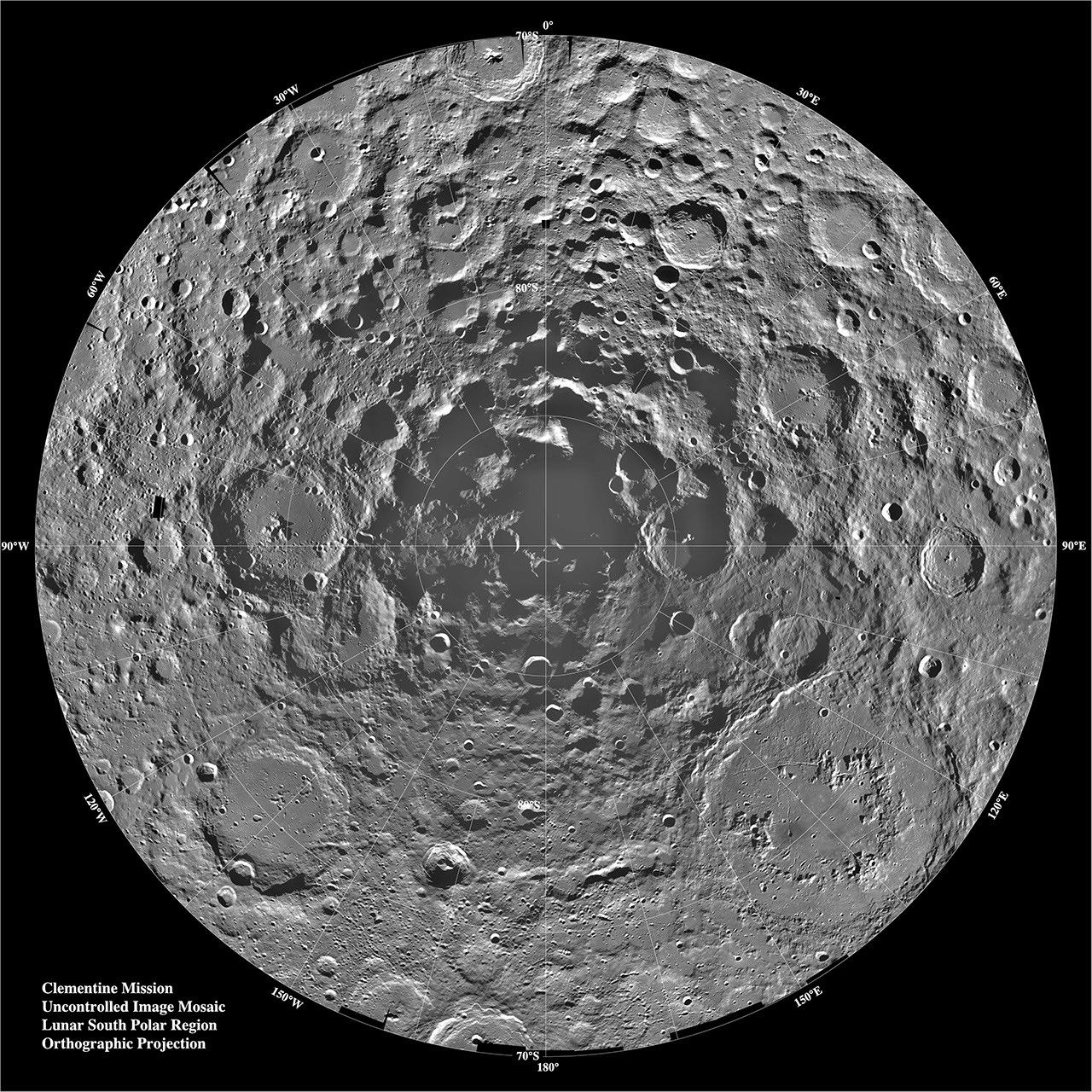By Paul D. Spudis, Lunar and Planetary Institute
The Moon has held our imaginations for millennia, yet it is only in modern times that we have visited this body, first with robotic machines and then with astronauts. Exploration of the Moon has taught us much about the evolution of the solar system and ourselves. We’ve known for centuries about the effects on tides and biological cycles from a waxing and waning Moon. But it took space-age exploration to show us how the Moon is connected to human existence on a very fundamental level.
The Space Age arrives: Robots to the Moon
With the shocking launch of Sputnik 1 in October 1957, the Moon changed from a distant silver disk in the sky to a real place, a probable destination for probes and people. The Soviets struck first, flying Luna 1 by the Moon in January 1959. They followed this success with a number of other robotic probes, culminating later the same year with Luna 3, which photographed the far side of the Moon, never visible from Earth. From these early, poor quality images, we discovered that the far side has surprisingly little of the dark, smooth mare plains that cover about a third of the near side. Other surprises would soon follow.
In response to the 1961 flight of Soviet cosmonaut Yuri Gagarin, President John F. Kennedy committed the United States to landing a man on the Moon by the end of the decade. The Apollo program greatly accelerated interest in exploring the Moon. To ensure that human crews could safely land and depart from the lunar surface, it was important to understand its environment, surface and processes. At the same time, the robotic precursors would collect valuable information, constituting the first scientific exploration of another planetary body.
America’s first step was the Ranger series of hard landers. These probes were designed to photograph the lunar surface at increasing levels of detail before crashing into the surface. After several heartbreaking failures, Ranger 7 succeeded in sending back detailed television pictures of Mare Nubium (Sea of Clouds) in July 1964. From the Ranger probes, we discovered that craters, those strange holes that pepper the lunar surface, range down in size to the very limits of resolution. Micrometeorite bombardment has ground up the surface rocks, creating a fine powder (called regolith). Two more Ranger spacecraft flew to the Moon, culminating with the 1965 Live From the Moon television images from Ranger 9, careening into the spectacular lunar crater Alphonsus.
We got a much closer look at the Moon’s surface in early 1966. Again, the U.S.S.R. led the way by safely soft-landing the robotic Luna 9 spacecraft on the mare plain, Oceanus Procellarum. It found the surface to be powdery dirt strewn with a few rocks, but strong enough to support the weight of a landed spacecraft. In May 1966, the United States followed with the landing of the complex robotic spacecraft, Surveyor 1. It sent television pictures back to Earth, showing the surface and its physical properties in detail. Later Surveyor missions (five in all), collected physical data on soil properties, including its chemical composition. Analysis of the lunar surface showed that the dark maria had a composition similar to terrestrial basalt, a dark iron-rich lava, while the highlands near the very fresh rayed crater Tycho were lighter in color and strangely enriched in aluminum. This led to an astonishing revelation about the Moon’s early history after the first physical samples were later returned to Earth by the Apollo 11 crew.
The final robotic missions mapped the entire Moon from orbit for the first time and obtained extremely high resolution pictures of potential landing sites, certifying their safety for the Apollo missions to follow. This U.S. Lunar Orbiter series conducted five mapping missions, whereby boulders as small as a couple of meters could be seen. They also obtained amazing views of scientifically interesting targets, such as the first “pilot’s eye” view of the large, brightly rayed crater Copernicus, dubbed the “picture of the century” by news reporters. More “pictures of the century” were soon to be obtained by people walking on the Moon.
From these robotic missions, we learned that the Moon was cratered and pitted at all scales. The surface was powdery dust but strong enough to support the weight of people and machines. The Moon had no global magnetic field or atmosphere and was made up of common rock types, similar to those found on Earth. Now the stage was set for the next giant leap in understanding lunar and planetary history.
Apollo: The Humans Follow
Apollo was the finest hour of America’s space program. In just eight years, we had gone from zero human spaceflight capability to landing men on the surface of the Moon. From these missions, scientists developed a new view of the origin and evolution of the planets and of life on Earth.
The 1968 Christmastime flight of Apollo 8 was a milestone – humans left low Earth orbit and reached the Moon, circling it for almost a day. For the first time, people gazed on the Moon from orbit. They found it desolate and gray, but saw nothing to prevent journeying the final 62 miles to the surface. In May of 1969, Apollo 10 orbited the Moon, testing the lunar lander. It was a dress rehearsal for the manned landing to come. Each of the Apollo missions – and the astronauts who remained in the orbiting Command Module during the subsequent landed missions – took hundreds of high-resolution photographs of the Moon’s surface. Their visual observations added to the burgeoning knowledge of lunar geology.
In a harrowing descent marked by program alarms from an overloaded computer and freezing fuel lines, Neil Armstrong and Buzz Aldrin in Apollo 11 safely landed in Mare Tranquillitatis (Sea of Tranquility) on July 20, 1969. They walked on the Moon for over 2 hours, collecting rocks and soil and laying out experiment packages. From the Apollo 11 samples, we learned that the dark maria are ancient volcanic lavas, having crystallized over 3.6 billion years ago. Lunar samples are similar in chemical composition to Earth rocks but extremely dry, with no evidence for any significant water on the Moon, past or present. Small bits of white rock were found in the soil, blasted to the site from distant highlands. Combined with the earlier results of the Surveyor 7 chemical analysis at the crater Tycho, scientists reasoned that the ancient Moon had been nearly completely molten, covered in a layer of liquid rock. This idea of an early “magma ocean” has since been applied to all the rocky planets. Micrometeorite bombardment ground up the bedrock and gases from the sun were implanted on the surfaces of the lunar dust grains. While preserved on the Moon, most of this ancient, shared history has been lost on our geologically active Earth.
In November 1969, Apollo 12 touched down in Oceanus Procellarum (Ocean of Storms), near the previously landed Surveyor 3 spacecraft. This mission demonstrated our ability to precisely land on the Moon, a skill critical for navigating to future sites in the highlands and rugged areas. Astronauts Pete Conrad and Alan Bean explored the site in two moonwalks. They collected over 75 pounds of samples and deployed a nuclear-powered experiment package. Lavas from this landing site are slightly younger than those of Apollo 11, but still over 3.1 billion years old. The highland component here is different from that of the first landing; it has an unusual enrichment in radioactive and rare-earth elements, suggesting that the Moon’s crust is laterally variable and complex. As a bonus, the crew also returned a light colored soil, possibly part of a “ray” cast-off and flung outward during the formation of the distant crater Copernicus – 186 miles north of the landing site. Dating of glass from this soil suggests that Copernicus is “only” 900 million years old, ancient by Earth standards but one of the youngest major features on the Moon.
The explosion of an oxygen tank on Apollo 13 prevented it from landing on the Moon. The three-man crew returned safely to Earth — a memorable saga closely followed around the world. Apollo 14 was sent to a highlands site east of Apollo 12, near the ancient crater Fra Mauro. This site was chosen to collect rocks blasted out from deep within the Moon by the formation of the giant Imbrium impact basin, a crater over 620 miles in diameter and situated 3,723 miles north of the landing site. Astronauts Alan Shepard and Edgar Mitchell conducted two moonwalks on the lunar surface. Towing a pull-cart filled with tools, they returned over 95 pounds of rock and soil. Samples from the Fra Mauro highlands are breccias (complex mixtures of ancient rocks), broken and crushed by the giant impact that created the Imbrium basin. From these samples, scientists learned the Imbrium impact occurred more than 3.8 billion years ago, before the dark mare lavas flooded the Moon’s surface but well after the formation of the Moon’s crust over 4.4 billion years ago. After this third landing, a new picture of lunar evolution was emerging. The Moon was not a simple lump of cold meteorite nor was it an active volcanic inferno, but a planetary body with its own complex, subtle history.
In July 1971, with Apollo 15, NASA began the first of three what were termed "J" missions – long duration stays on the Moon with a greater focus on science than had been possible previously. Apollo 15, whose lunar module Falcon spent three days on the lunar surface, was the first mission to use a lunar rover — a small electric cart that allowed the crew to travel many kilometers away from their landing craft. On three lunar rover excursions Dave Scott and Jim Irwin explored the beautiful Hadley-Apennine landing site — a valley at the base of the main rim of the huge Imbrium basin that included both mare and highland rocks. The crew returned the “Genesis Rock,” composed almost entirely of a single mineral (plagioclase feldspar), representing the most ancient crustal rocks on the Moon. They also found small fragments of an emerald green glass, formed when magma from the deep mantle explosively erupted through the crust in a spray of lava. They sampled the mare bedrock at the edge of Hadley Rille, a giant canyon and ancient lava channel, formed over 3.3 billion years ago. The Apollo 15 mission obtained over 80 kilograms of samples and its command module carried chemical sensors and cameras that mapped almost 20 percent of the Moon’s surface from orbit.
Apollo 16 was sent to the ancient crater Descartes, deep in the lunar highlands in April 1972. Astronauts John Young and Charlie Duke spent three days exploring the site. They traveled over 18 miles and collected more than 206 pounds of samples. They deployed and operated the first astronomical telescope on the Moon. The highlands rocks, almost all breccias, attest to a long and complicated history of repeated impacts from space. Ancient crustal rocks, similar to the Genesis Rock of Apollo 15, were also found. One puzzling observation by the crew was the measurement of a very strong magnetic field on the surface. Even though the Moon has no global magnetic field, some lunar samples have remnant magnetism, suggesting that they cooled in the presence of strong fields. Although we still do not understand lunar magnetism, with the flight of Lunar Prospector 26 years later, the Apollo 16 result would become a little clearer.
The last human mission to the Moon to date, Apollo 17, was sent to the edge of Mare Serenitatis (Sea of Serenity) -- another combination mare/highland site -- in December 1972. Gene Cernan and Jack Schmitt (the first professional geologist sent to the Moon) spent three days thoroughly exploring the Taurus-Littrow valley. They returned over 242 pounds of samples and deployed a set of new surface experiments. They made startling and significant discoveries. The crew found 3.6-billion-year old orange volcanic ash. From the mountains, they returned crustal rocks and complex breccias created during the impact that formed the Serenitatis basin almost 3.9 billion years ago. Lavas at this site are over 3.6 billion years old, documenting at least a 700-million-year span of lava flooding on the Moon.
The Apollo missions revolutionized planetary science. The early solar system was one of colliding planets, melted surfaces and exploding volcanoes — a complex and violent geologic mixture. The concept of an “early bombardment” 3.9 billion years ago is now widely accepted for all the planets, but the actual evidence comes from study of the lunar samples. The constant rain of micrometeorites grinds away all airless planetary surfaces, albeit this sandblaster is extremely slow (the Moon erodes at a rate of roughly 1 millimeter per million years.) While Apollo did a magnificent job of outlining lunar history, more surprises were waiting to be unveiled.
The Robots Return: Clementine and Lunar Prospector
In the 1990s, two small robotic missions were sent to the Moon. For 71 days in 1994, the joint NASA-Strategic Defense Initiative Organization Clementine mission orbited the Moon, testing sensors developed for space-based missile defense, as well as mapping the color and shape of the Moon. From Clementine, we documented the enormous south pole-Aitken impact basin, a hole in the Moon 1, 616 miles across and over 8 miles deep. This basin is so large, it may have excavated the entire crust down to the mantle. The color data from Clementine, combined with Apollo sample information, allows us to map regional compositions, creating the first true “rock map” of the Moon. Finally, Clementine gave us a tantalizing hint that permanently dark areas near the south pole of the Moon may contain frozen water deposited over millions of years by impacting comets.
Soon after Clementine, the Lunar Prospector spacecraft mapped the Moon’s surface from orbit during its mission in 1998 and 1999. These data, combined with those from Clementine, gave scientists global compositional maps showing the complicated crust of the Moon. Lunar Prospector also mapped the surface magnetic fields for the first time. The data showed that the Apollo 16 Descartes highlands is one of the strongest magnetic areas on the Moon, explaining the surface measurements made by John Young in 1972. The mission also found enhanced quantities of hydrogen at both poles, adding to the lively controversy over the welcome prospect for lunar ice.
The Moon throws stones at us: Lunar meteorites
In 1982, we made a startling discovery. A meteorite found in Antarctica, ALHA 81005, is from the Moon! The rock is a complex regolith breccia, similar to those returned by the Apollo 16 mission in 1972. We have since found over 50 meteorites that, as determined from their unique chemical composition, come from the Moon. These rocks were blasted off the lunar surface by impacts, then captured and swept up by Earth as it moves through space. The lunar meteorites come from random places all over the Moon and they provide data complementary to the Apollo samples and the global maps of composition obtained by Clementine and Lunar Prospector.
The Future and Significance of Lunar Exploration
Now we are preparing for humanity’s return to the Moon. Over the next couple of years, at least four international robotic missions will orbit the Moon, making global maps of unsurpassed quality. We will soft land on the Moon, particularly the mysterious polar regions, to map the surface, examine the volatile deposits and characterize the unusual environment there. Ultimately, people will return to the Moon. The goals of lunar return this time are not to prove that we can do it (as Apollo did) but to learn how to use the Moon to support a new and growing spacefaring capability. On the Moon, we will learn the skills and develop the technologies needed to live and work on another world. We will use this knowledge and technology to open the solar system for human exploration.
The story of the Moon’s history and processes is interesting in its own right, but it has also subtly shifted perspectives on our own origins. One of the most significant discoveries of the 1980s was the giant impact 65 million years ago in Mexico that led to the extinction of the dinosaurs, allowing the subsequent rise of mammals. This discovery (made possible by recognizing and interpreting the telltale chemical and physical signs of hypervelocity impact) came directly from the study of impact rocks and landforms stimulated by Apollo. Scientists now think that impacts are responsible for many, if not most, extinction events in the history of life on Earth. The Moon retains this record and we will read it in detail upon our return.
By going to the Moon, we continue to obtain new insights into how the universe works and our own origins. Lunar exploration revolutionized understanding of the collision of solid bodies. This process, previously thought to be bizarre and unusual, is now viewed as fundamental to planetary origin and evolution – an unexpected connection. By returning to the Moon, we anticipate learning even more about our past, and equally importantly, obtaining a glimpse into our future.

































